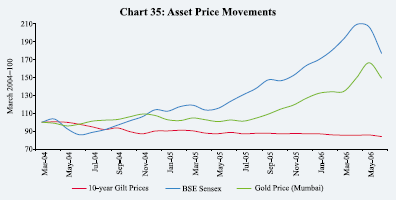IV. Price Situation - RBI - Reserve Bank of India
IV. Price Situation
Headline inflation firmed up further in several countries during the first quarter of 2006-07 in response to sustained pressures from record high international crude oil prices. Core inflation and inflation expectations which had so far remained relatively benign have also edged higher in recent months. With a significant part of the increase in international crude oil prices being considered as permanent, many central banks tightened monetary policies further to contain inflation and inflationary expectations. With inflation turning higher than anticipated, this raised fears of US monetary tightening going further than expected hitherto. This, in turn, seems to have unnerved global financial and commodity markets during May-June 2006.
In India, supply-side factors continued to be the major factors driving inflation during the first quarter of 2006-07. Apart from higher oil prices, primary food articles prices also posed upward pressure on inflation in the first quarter. Nonetheless, headline inflation remained within the indicative trajectory during the first quarter of 2006-07 although underlying inflation pressures continued. Pre-emptive monetary and fiscal measures have helped in containing inflationary expectations.
Global Inflation
Headline inflation firmed up further in the first quarter of 2006-07 in a number of economies in tandem with the movements in international crude oil prices (Chart 24). With oil prices reaching a new high of over US $ 75 a barrel in
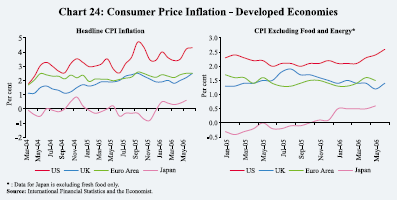
April 2006, headline inflation edged up sharply in major advanced economies in June 2006 exceeding the accepted levels/targets – inflation, year-on-year (y-o-y), reached 4.3 per cent in the US and 2.5 per cent each in the Euro area and in the UK. Core inflation, which had till recently remained relatively stable, has also shown signs of some increase in recent months. Many central banks have, therefore, continued to tighten monetary policy during 2006 in order to contain inflation and inflationary expectations, especially in view of continued strength of demand and possible stronger pass-through of previous increases in oil prices.
In the US, with rising resource utilisation and elevated energy and other commodity prices viewed as having the potential to add to inflationary pressures, the US Federal Reserve raised its target federal funds rate further by 50 basis points during April-June 2006 – 25 basis points each in May and June 2006 to 5.25 per cent. The fed funds rate has thus increased by 425 basis points since the tightening began in June 2004 (i.e., 25 basis points hike at each of its 17 meetings) (Chart 25). The US Federal Open Market Committee (FOMC) has noted that the extent and timing of any additional firming that may be needed will depend on the evolution of the outlook for both inflation and economic growth, as implied by incoming information. In the Euro area, inflation is expected to remain above the target of ‘below but close to 2.0 per cent’ in the coming months due to upside risks from further increases in oil prices, the possibility of stronger pass-through of past oil price rises, and additional increases in administered prices and indirect taxes. The European Central Bank (ECB), therefore, raised the key policy rate by 25 basis points again in June 2006 – a total increase of 75 basis points since December 2005 – to keep inflation expectations in the Euro-area anchored to levels consistent with price stability. The Reserve Bank of Australia also raised its policy rate in May 2006 – after a gap of more than one
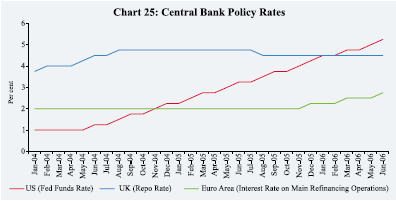
year – by 25 basis points to 5.75 per cent in response to strong economic activity and underlying inflation pressures. Amongst other advanced economies, Sweden, Norway and Switzerland raised their policy rates by 25 basis points each while Canada raised rates by 50 basis points during the quarter ended June 2006 in view of inflationary pressures.
In the UK, on the other hand, the Bank of England after cutting its policy rate by 25 basis points on August 4, 2005 has kept it unchanged since then. In Japan, year-on-year consumer price inflation has turned positive since January 2006. The Bank of Japan (BoJ) expects the economy to expand for a sustained period and the year-on-year change in the consumer prices is also projected to continue to follow a positive trend. Accordingly, after maintaining zero interest rates for an extended period, the BoJ on July 14, 2006 decided to increase the uncollateralised overnight call rate (adopted as the operating target for monetary policy since March 2006) by 25 basis points (Table 24).
| Table 24: Global Inflation Indicators |
|||||||||||
| (Per cent) |
|||||||||||
| Country/ |
Key Policy Rate |
Policy Rates |
Changes in |
CPI Inflation |
Growth |
||||||
| Region |
(As on |
Policy Rates |
(y-o-y) |
(y-o-y) |
|||||||
| (basis points) |
|||||||||||
| July 19, 2006) |
|||||||||||
| Since |
Since |
2005 |
2006 |
2005 |
2006 |
||||||
| end- |
end- |
(May) |
(May) |
(Q1) |
(Q1) |
||||||
| March |
March |
||||||||||
| 2005 |
2006 |
||||||||||
| 1 |
2 |
3 |
4 |
5 |
6 |
7 |
8 |
9 |
|||
| Developed |
Economies |
||||||||||
| Australia |
Cash Rate |
5.75 |
25 |
25 |
2.4 |
3.0 # |
1.9 |
3.1 |
|||
| Canada |
Overnight Rate |
4.25 |
175 |
50 |
1.6 |
2.8 |
3.3 |
3.2 |
|||
| Euro area |
Interest Rate on Main |
2.75 |
75 |
25 |
2.1 |
2.5 @ |
1.5 |
1.9 |
|||
| Refinancing Operations |
|||||||||||
| Japan |
Uncollateralised |
0.25 |
** |
25 |
0.2 |
0.6 |
1.1 |
3.8 |
|||
| Overnight Call Rate |
|||||||||||
| UK |
Repo Rate |
4.50 |
(-)25 |
0 |
2.0 |
2.5 @ |
1.9 |
2.3 |
|||
| US |
Federal Funds Rate |
5.25 |
250 |
50 |
2.5 |
4.3 @ |
3.6 |
3.7 |
|||
| Developing |
Economies |
||||||||||
| Brazil |
Selic Rate |
15.25 |
(-)400 |
(-)125 |
7.3 |
4.0 @ |
2.6 |
3.4 |
|||
| India |
Reverse Repo Rate |
5.75 |
100 |
25 |
3.7 |
6.3 |
8.6 |
9.3 |
|||
| Indonesia |
BI Rate |
12.25 |
375 * |
(-)50 |
7.4 |
15.5 @ |
6.4 |
4.6 |
|||
| Israel |
Key Rate |
5.25 |
175 |
50 |
0.2 |
3.5 |
4.1 |
5.2 |
|||
| Korea |
Overnight Call Rate |
4.25 |
100 |
25 |
2.7 |
2.6 @ |
2.7 |
6.1 |
|||
| Philippines |
Reverse Repo Rate |
7.50 |
75 |
0 |
7.6 |
6.7 |
4.6 |
5.5 |
|||
| South Africa |
Repo Rate |
7.50 |
0 |
50 |
3.3 |
3.9 |
4.2 |
4.0 |
|||
| Thailand |
14-day Repo Rate |
5.00 |
275 |
50 |
3.8 |
5.9 @ |
3.3 |
6.0 |
|||
| y-o-y : year-on-year. # : First quarter of 2006. @ : June. * : Change since July 2005. |
|||||||||||
In emerging Asia, with inflation remaining firm, many central banks further tightened their monetary policies to stabilise inflationary expectations. In Thailand, although core inflation has remained within the target range in 2006 so far, the Bank of Thailand raised policy rates by 25 basis points each in April and June 2006 to 5.0 per cent – a total hike of 275 basis points since end-March 2005. In Korea, even though inflation remains modest, inflationary pressures seen from strong economic recovery and high oil prices prompted the Bank of Korea to raise the policy rate by 25 basis points to 4.25 per cent in June 2006 – a total of 100 basis points since the tightening began in October 2005. The Bank Indonesia, which had raised policy rates by 425 basis points during July-December 2005, cut the policy rate by 25 basis points each in May and July 2006 to 12.25 per cent to support growth. Inflation still remains high, although there has been some moderation from its recent peak of 18.4 per cent in November 2005 to 15.5 per cent in June 2006. The Bank of Philippines has maintained the policy reverse repo rates at 7.5 per cent since October 2005 (when it had raised the rate by 25 basis points) on expectations of deceleration in inflation by the second-half of 2006. On the other hand, despite strong growth, consumer price inflation in China decelerated to 1.4 per cent in May 2006 from 1.8 per cent a year ago, mainly due to lower prices of meat and poultry products as well as downward pressures on prices in some sectors reflecting excess capacity (Chart 26). Nonetheless, China increased the benchmark 1-year lending rate by 27 basis points effective April 28, 2006 and raised the cash reserve ratio by 50 basis points to 8.0 per cent effective July 5, 2006 in view of stronger growth in money supply and credit. Amongst other emerging economies, South Africa – after having kept policy rates unchanged since April 2005 – raised the policy rates by 50 basis points to 7.50 per cent in June 2006. Turkey increased its policy rate by 175 basis points on
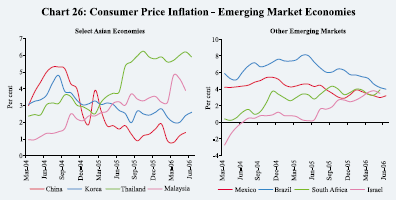
June 8, 2006 and another 225 basis points on June 25, 2006 as inflation rate significantly exceeded the target path and on concerns over the possible pass-through effect of the exchange rate movements arising from the recent volatility in international financial markets. On the other hand, in view of weak economic activity, Brazil has reduced policy rates on eight occasions since September 2005 to 15.25 per cent on May 31, 2006.
Global Commodity Prices
International commodity prices rose further during the first quarter of 2006-07, led by crude oil and metals prices, reflecting robust economic activity and supply constraints (Chart 27). Crude oil prices reached new record highs reflecting tight supply conditions and geo-political factors. Non-fuel commodity prices also increased led by metals reflecting strong demand, higher energy prices, lags in supply and interest by investors in commodity markets – albeit with some corrections during May-June 2006 following concerns that further monetary tightening might slow global growth and demand.
International crude oil prices which rose to record highs during 2005-06 firmed up further during the first quarter of 2006-07. Despite some deceleration in growth in global oil demand during 2005, oil prices continued to firm up reflecting limited surplus capacity and geo-political uncertainties (Table 25). WTI prices reached a new high of US $ 75.3 a barrel on April 21, 2006 reflecting renewed concerns over Iran’s nuclear programme and unrest in Nigeria. Prices eased marginally in subsequent weeks to around US $ 70 a barrel, partly on concerns of likely slowdown in demand in view of further monetary tightening. However, they again edged higher on concerns of geo-political uncertainties in the Middle East and reached a new record high of
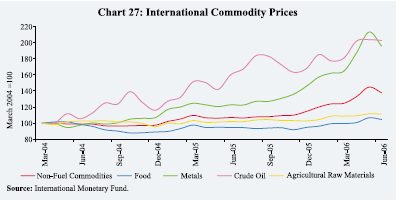
| Table 25: International Crude Oil Prices |
|||||
| (US dollars per barrel) |
|||||
| Year/Month |
Dubai Crude |
UK Brent |
US WTI |
Average Crude Price |
Indian Basket Price |
| 1 |
2 |
3 |
4 |
5 |
6 |
| 2001-02 |
21.8 |
23.2 |
24.1 |
23.0 |
22.4 |
| 2002-03 |
25.9 |
27.6 |
29.2 |
27.6 |
26.6 |
| 2003-04 |
26.9 |
29.0 |
31.4 |
29.1 |
27.8 |
| 2004-05 |
36.4 |
42.2 |
45.0 |
41.3 |
38.9 |
| 2005-06 |
53.4 |
58.0 |
59.9 |
57.1 |
55.4 |
| March 2004 |
30.5 |
33.8 |
36.7 |
33.7 |
31.9 |
| March 2005 |
45.6 |
53.1 |
54.2 |
50.9 |
48.8 |
| March 2006 |
57.7 |
62.3 |
62.9 |
60.9 |
59.6 |
| April 2006 |
64.1 |
70.4 |
69.4 |
68.0 |
66.8 |
| May 2006 |
64.9 |
70.2 |
70.9 |
68.7 |
67.2 |
| June 2006 |
65.1 |
68.9 |
70.9 |
68.3 |
66.7 |
| Source : International Monetary Fund and the World Bank. |
|||||
US $ 78.4 a barrel on July 14, 2006. Average international crude oil prices, which had increased by 38.3 per cent to US $ 57.1 a barrel in 2005-06, rose further by about 12 per cent between March 2006 and June 2006.
With limited surplus global crude oil production capacity and the U.S. oil production and refining industries still to recover fully, oil prices are expected to remain firm in the near future (Table 26). The Energy Information Administration (EIA) of the US, therefore, expects WTI prices to average US $ 69.1 per barrel in calendar year 2006, an increase of about 22 per cent over the price prevailing in 2005 (US $ 56.5 per barrel).
Metal prices firmed up sharply during April and early May 2006 with prices reaching record highs/multi-year highs on the back of robust construction and
| Table 26: World Supply-Demand Balance of Oil |
||||||||
| (Million barrels per day) |
||||||||
| Item |
2003 |
2004 |
2005 |
2006 (P) |
2006 P |
|||
| Q1 |
Q2 |
Q3 |
Q4 |
|||||
| 1 |
2 |
3 |
4 |
5 |
6 |
7 |
8 |
9 |
| Demand |
||||||||
| 1. OECD |
48.7 |
49.5 |
49.6 |
49.9 |
50.2 |
48.8 |
49.9 |
50.8 |
| 2. Non-OECD |
31.2 |
33.0 |
34.4 |
35.6 |
35.1 |
35.2 |
35.4 |
36.8 |
| of which: China |
5.6 |
6.5 |
6.9 |
7.4 |
7.2 |
7.3 |
7.4 |
7.6 |
| 3. Total (1+2) |
79.9 |
82.5 |
84.0 |
85.6 |
85.3 |
84.0 |
85.4 |
87.6 |
| Supply |
||||||||
| 4. Non-OPEC |
48.9 |
50.1 |
50.1 |
50.9 |
50.7 |
50.4 |
51.0 |
51.6 |
| 5. OPEC |
30.7 |
32.9 |
33.9 |
34.1 |
33.7 |
33.5 |
34.5 |
34.7 |
| 6. Total (4+5) |
79.6 |
83.1 |
84.0 |
85.0 |
84.4 |
83.9 |
85.5 |
86.3 |
| Stock Changes |
0.3 |
-0.6 |
-0.1 |
0.5 |
0.9 |
0.1 |
-0.1 |
1.3 |
| P: Projections. |
||||||||
manufacturing demand from China and the US, and supply constraints amidst growing investors’ interest. The rally in metal prices was led by copper, zinc and aluminium, reflecting decline in inventories to historical lows as well as a series of supply disturbances, including the labour strikes in the US and Chile in the copper industry (Table 27). As a result, the IMF’s metals price index rose by 77 per cent y-o-y in May 2006. However, following the release of higher than anticipated US inflation data for April 2006, global metal prices witnessed correction from mid-May 2006 onwards on fears that further monetary tightening by the US might slow down demand for metals. Consequently, prices of copper, aluminium and zinc on the London Metal Exchange (LME) fell by 18 per cent, 17 per cent and 16 per cent, respectively, between May 17, 2006 and June 29, 2006 (Chart 28). Notwithstanding this correction, prices are still substantially higher than their levels a year ago –prices of copper and zinc during June 2006 were higher by about 104 per cent and 153 per cent, respectively, over June 2005 levels. International steel prices which had stabilised in the second half of 2005 edged higher in June 2006.
Sugar prices, which had increased sharply in the second half of 2005-06, eased during May-June 2006. Notwithstanding this easing, global sugar prices during April-June 2006 were almost double of their levels a year ago reflecting a decline in global inventories and higher global sugar consumption, especially from the developing countries of the Far East and Latin America. Wheat and rice prices
| Table 27: International Commodity Prices |
||||||||||
| Commodity |
Unit |
2004 |
2005 |
2005 |
2006 |
2006 |
||||
| Apr-Jun |
Jan-Mar |
Apr-Jun |
Mar |
Apr |
May |
Jun |
||||
| 1 |
2 |
3 |
4 |
5 |
6 |
7 |
8 |
9 |
10 |
11 |
| Energy |
||||||||||
| Coal |
$/mt |
53.0 |
47.6 |
51.2 |
46.9 |
52.6 |
49.8 |
52.9 |
52.6 |
52.4 |
| Crude oil (Average) |
$/bbl |
37.7 |
53.4 |
50.8 |
61.0 |
68.3 |
60.9 |
68.0 |
68.7 |
68.3 |
| Non-Energy Commodities |
||||||||||
| Palm oil |
$/mt |
471.3 |
422.1 |
421.7 |
436.4 |
438.7 |
440.0 |
439.0 |
440.0 |
437.0 |
| Soybean oil |
$/mt |
616.0 |
544.9 |
548.0 |
535.3 |
576.3 |
539.0 |
541.0 |
588.0 |
601.0 |
| Soybeans |
$/mt |
306.5 |
274.7 |
290.7 |
256.7 |
263.7 |
256.0 |
258.0 |
266.0 |
267.0 |
| Rice |
$/mt |
237.7 |
286.3 |
292.0 |
298.8 |
307.6 |
303.5 |
302.3 |
308.0 |
312.5 |
| Wheat |
$/mt |
156.9 |
152.4 |
142.0 |
173.8 |
189.6 |
174.4 |
180.3 |
193.2 |
195.2 |
| Sugar |
c/kg |
15.8 |
21.8 |
19.3 |
37.5 |
36.5 |
38.0 |
38.6 |
37.1 |
34.0 |
| Cotton A Index |
c/kg |
136.6 |
121.7 |
122.6 |
131.1 |
121.8 |
129.3 |
123.7 |
120.2 |
121.5 |
| DAP |
$/mt |
221.2 |
247.0 |
235.6 |
259.6 |
266.9 |
256.6 |
260.8 |
270.8 |
269.2 |
| Urea |
$/mt |
175.3 |
219.0 |
241.6 |
219.2 |
228.1 |
244.1 |
248.4 |
227.8 |
208.2 |
| Aluminium |
$/mt |
1715.5 |
1898.3 |
1790.0 |
2420.8 |
2653.0 |
2429.0 |
2621.0 |
2861.0 |
2477.0 |
| Copper |
$/mt |
2865.9 |
3678.9 |
3389.0 |
4940.0 |
7210.0 |
5103.0 |
6388.0 |
8046.0 |
7198.0 |
| Gold |
$/toz |
409.2 |
444.8 |
427.3 |
554.0 |
627.4 |
557.1 |
610.7 |
675.4 |
596.1 |
| Silver |
c/toz |
669.0 |
733.8 |
718.2 |
969.4 |
1226.1 |
1037.5 |
1263.2 |
1337.8 |
1077.4 |
| Steel products index |
1990=100 |
121.5 |
137.9 |
141.6 |
138.6 |
131.6 |
138.6 |
138.6 |
125.2 |
131.2 |
| Steel cold-rolled coil/sheet |
$/mt |
607.1 |
733.3 |
750.0 |
750.0 |
666.7 |
750.0 |
750.0 |
600.0 |
650.0 |
| Steel hot-rolled coil/sheet |
$/mt |
502.5 |
633.3 |
650.0 |
650.0 |
591.7 |
650.0 |
650.0 |
550.0 |
575.0 |
| Tin |
c/kg |
851.3 |
738.0 |
796.3 |
760.6 |
852.9 |
794.0 |
885.3 |
883.7 |
789.6 |
| Zinc |
c/kg |
104.8 |
138.1 |
127.3 |
224.2 |
329.2 |
241.7 |
308.5 |
356.6 |
322.6 |
| $: US dollar. c: US cent. bbl: barrel. mt: metric tonne. kg: Kilogram. toz: troy oz. |
||||||||||
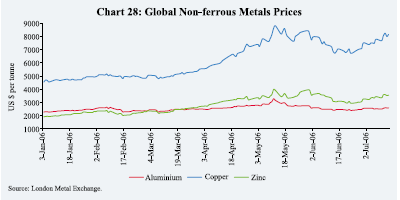
have firmed up since the second half of 2005 due to lower production, higher demand from many countries in Asia, and a tightening of export availabilities in major exporting countries. Prices of oilseeds and edible oils have also edged up in recent months due to strong consumption demand from China and India and demand for non-food uses such as biodiesel from the EU and the US. Global cotton prices have eased in recent months (see Table 27).
Inflation Conditions in India
Taking into account the real economy, monetary and global factors having a bearing on domestic prices, the Reserve Bank in its Annual Policy Statement for 2006-07 (released in April 2006) noted that containing inflationary expectations would continue to pose a challenge to monetary management. The policy endeavour would be to contain the year-on-year inflation rate for 2006-07 in the range of 5.0-5.5 per cent.
Inflation movements continued to be driven by supply shocks in the first quarter of 2006-07. Apart from sustained pressures from oil prices, primary food articles prices also posed upward pressures. Nonetheless, headline inflation remained within the indicative trajectory although underlying inflation pressures continued. Inflation expectations remained largely stable, reflecting pre-emptive monetary policy actions which have helped in anchoring inflation expectations. In order to stabilise inflation expectations as also taking into account the global interest rate cycle, the Reserve Bank increased the LAF reverse repo rate and the repo rate by a further 25 basis points each effective June 9, 2006 (Table 28). The pass-through of international oil prices to domestic prices in a phased manner amidst the burden sharing strategy by oil companies as well as duty reductions
| Table 28: Movement in Key Policy Rates |
||||
| (Per cent) |
||||
| Effective since |
Reverse Repo Rate |
Repo Rate |
Effective since |
CRR |
| 1 |
2 |
3 |
4 |
5 |
| March 5, 2002 |
6.00 |
8.50 |
December 29, 2001 |
5.50 |
| March 28, 2002 |
6.00 |
8.00 |
June 1, 2002 |
5.00 |
| June 27, 2002 |
5.75 |
8.00 |
November 16, 2002 |
4.75 |
| October 30, 2002 |
5.50 |
8.00 |
June 14, 2003 |
4.50 |
| November 12, 2002 |
5.50 |
7.50 |
September 18, 2004 |
4.75 |
| March 3, 2003 |
5.00 |
7.50 |
October 2, 2004 |
5.00 |
| March 7, 2003 |
5.00 |
7.10 |
||
| March 19, 2003 |
5.00 |
7.00 |
||
| August 25, 2003 |
4.50 |
7.00 |
||
| March 31, 2004 |
4.50 |
6.00 |
||
| October 27, 2004 |
4.75 |
6.00 |
||
| April 29, 2005 |
5.00 |
6.00 |
||
| October 26, 2005 |
5.25 |
6.25 |
||
| January 24, 2006 |
5.50 |
6.50 |
||
| June 9, 2006 |
5.75 |
6.75 |
||
| Note : With effect from October 29, 2004, nomenclature of repo and reverse repo has been interchanged |
||||
also mitigated the immediate cost push impact of international crude oil prices. Furthermore, competitive pressures, corporate profitability and productivity gains in several sectors have enabled corporates to absorb a part of the higher input costs into their profit margins. This has partially helped in abating the second order effects of higher oil prices and contained manufactured products inflation.
Headline inflation, based on movement in the wholesale price index (WPI), eased initially to 3.7 per cent as on April 15, 2006 from 4.1 per cent at end-March 2006, reflecting partly the base effect of higher prices last year. Inflation rate edged up somewhat in May-June 2006 to reach 5.4 per cent on June 17, 2006 reflecting higher prices of petrol and diesel, vegetables, milk and metals. Subsequently, inflation moderated to 5.0 per cent during the week ended July 1, 2006 on account of decline in the prices of fruits and milk as well as base effects (Table 29). The average WPI inflation rate eased to 4.3 per cent as on July 1, 2006 from 6.3 per cent a year ago.
Fuel prices continue to dominate the inflation outcome, notwithstanding the incomplete pass-through (Chart 29). In view of sustained rise in international crude oil prices, domestic petrol and diesel prices which were last raised in September 2005 were again increased by about Rs.4 (around nine per cent) and Rs.2 (around six per cent), respectively, effective June 6, 2006. Apart from raising oil prices, the Government also announced the following measures: i) reduction in customs duty on petrol and diesel to 7.5 per cent from the existing 10.0 per cent, ii) movement to trade parity pricing mechanism for petrol and diesel from the existing system of import parity pricing, and iii) issuance of oil bonds worth Rs.28,000 crore (over and
| Table 29: Wholesale Price Inflation in India (year-on-year) |
|||||||||
| (Per cent) |
|||||||||
| Commodity |
2005-06 |
2005-06 |
2006-07 P |
||||||
| (March 25) |
(July 2) |
(July 1) |
|||||||
| Weight |
Inflation |
WC |
Inflation |
WC |
Inflation |
WC |
|||
| 1 |
2 |
3 |
4 |
5 |
6 |
7 |
8 |
||
| All Commodities |
100.0 |
4.1 |
100.0 |
4.1 |
100.0 |
5.0 |
100.0 |
||
| 1. |
Primary Articles |
22.0 |
5.4 |
28.3 |
0.2 |
0.9 |
7.4 |
31.9 |
|
| Food Articles |
15.4 |
6.6 |
24.2 |
3.4 |
12.4 |
7.7 |
23.4 |
||
| i. |
Rice |
2.4 |
2.7 |
1.4 |
4.4 |
2.3 |
1.3 |
0.6 |
|
| ii. |
Wheat |
1.4 |
12.9 |
4.3 |
3.0 |
1.0 |
8.8 |
2.3 |
|
| iii. |
Pulses |
0.6 |
33.2 |
4.4 |
7.2 |
1.0 |
31.9 |
3.7 |
|
| iv. |
Vegetables |
1.5 |
8.1 |
2.1 |
4.9 |
1.8 |
9.3 |
2.8 |
|
| v. |
Fruits |
1.5 |
-1.0 |
-0.5 |
10.3 |
3.7 |
-2.5 |
-0.8 |
|
| vi. |
Milk |
4.4 |
1.9 |
1.9 |
0.3 |
0.3 |
6.7 |
5.6 |
|
| vii. |
Eggs, Fish and Meat |
2.2 |
14.3 |
7.9 |
4.7 |
2.7 |
8.9 |
4.3 |
|
| Non-Food Articles |
6.1 |
-1.9 |
-2.7 |
-6.9 |
-10.6 |
1.8 |
2.1 |
||
| i. |
Raw Cotton |
1.4 |
-1.4 |
-0.4 |
-21.8 |
-7.1 |
2.6 |
0.5 |
|
| ii. |
Oil Seeds |
2.7 |
-7.8 |
-4.5 |
-7.0 |
-4.5 |
-5.2 |
-2.5 |
|
| iii. |
Sugarcane |
1.3 |
0.7 |
0.3 |
-0.7 |
-0.3 |
0.7 |
0.2 |
|
| Minerals |
0.5 |
43.6 |
6.8 |
-5.4 |
-1.0 |
47.2 |
6.4 |
||
| 2. |
Fuel, Power, Light and Lubricants |
14.2 |
8.9 |
47.9 |
10.5 |
53.4 |
7.3 |
33.0 |
|
| i. |
Mineral Oils |
7.0 |
13.2 |
39.8 |
15.3 |
42.2 |
13.3 |
33.9 |
|
| ii. |
Electricity |
5.5 |
4.5 |
8.2 |
6.2 |
11.1 |
-0.6 |
-0.9 |
|
| iii. |
Coal Mining |
1.8 |
0.0 |
0.0 |
0.4 |
0.2 |
0.0 |
0.0 |
|
| 3. |
Manufactured Products |
63.8 |
1.7 |
23.2 |
3.3 |
44.7 |
3.2 |
35.9 |
|
| i. |
Food Products |
11.5 |
0.9 |
2.2 |
1.0 |
2.5 |
2.0 |
4.2 |
|
| of which: Sugar |
3.6 |
6.6 |
4.9 |
12.4 |
8.3 |
8.4 |
5.1 |
||
| Edible Oils |
2.8 |
-2.4 |
-1.3 |
-5.9 |
-3.3 |
-0.7 |
-0.3 |
||
| Oil Cakes |
1.4 |
-10.0 |
-3.6 |
-12.2 |
-5.2 |
-4.7 |
-1.4 |
||
| ii. |
Cotton Textiles |
4.2 |
1.1 |
1.0 |
-11.9 |
-11.3 |
0.5 |
0.3 |
|
| iii. |
Man Made Fibre |
4.4 |
-4.6 |
-2.5 |
-3.9 |
-2.1 |
5.0 |
2.1 |
|
| iv. |
Chemicals and Chemical Products |
11.9 |
3.6 |
10.2 |
4.5 |
12.6 |
3.9 |
8.9 |
|
| of which : Fertilisers |
3.7 |
0.3 |
0.2 |
3.0 |
2.4 |
0.8 |
0.5 |
||
| v. |
Basic Metals, Alloys and Metal Products |
8.3 |
-2.9 |
-6.7 |
7.8 |
17.3 |
2.4 |
4.6 |
|
| of which: Iron and Steel |
3.6 |
-7.5 |
-8.7 |
6.3 |
7.1 |
-2.3 |
-2.2 |
||
| vi. |
Non-Metallic Mineral Products |
2.5 |
8.6 |
4.7 |
7.0 |
3.6 |
13.4 |
5.9 |
|
| of which: Cement |
1.7 |
13.0 |
4.8 |
7.1 |
2.4 |
19.8 |
5.8 |
||
| vii. |
Machinery and Machine Tools |
8.4 |
3.9 |
6.1 |
7.6 |
11.2 |
3.3 |
4.3 |
|
| viii. |
Transport Equipment and Parts |
4.3 |
1.2 |
1.1 |
5.0 |
4.2 |
1.1 |
0.8 |
|
| Memo: |
|||||||||
| Food Items (Composite) |
26.9 |
4.2 |
26.5 |
2.4 |
14.9 |
5.3 |
27.6 |
||
| WPI Excluding Food |
73.1 |
4.0 |
73.5 |
4.8 |
85.1 |
4.8 |
72.4 |
||
| WPI Excluding Fuel |
85.8 |
2.7 |
52.1 |
2.4 |
46.6 |
4.3 |
67.0 |
||
| P: Provisional. WC : Weighted Contribution. |
|||||||||
above Rs.11,500 crore issued during 2005-06) to oil marketing companies to compensate for their under-recoveries in domestic operations.
Although fuel prices have been the key driver of domestic inflation, domestic petroleum products prices still lag the increase in international crude oil prices. As compared with more than doubling of international crude oil prices (the Indian basket) between March 2004 and June 2006 (from US $ 31.9 a barrel to
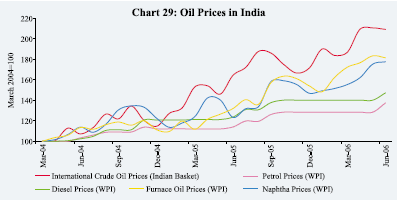
US $ 66.7 a barrel), domestic mineral oils prices in the WPI basket have increased by about 38.4 per cent over the same period (up to July 1, 2006) – petrol by 40.3 per cent and high-speed diesel by 49.5 per cent. The pass-through of higher international oil prices has been restricted to petrol and diesel. Domestic prices of liquefied petroleum gas (LPG) have remained unchanged since November 2004 while kerosene prices have been unchanged since April 2002 on grounds of social concerns. Notwithstanding this phased and incomplete pass-through, mineral oils inflation alone contributed almost one-third to the headline inflation. Accordingly, the y-o-y WPI inflation excluding the fuel group at 4.3 per cent as on July 1, 2006 remained below the headline rate (Chart 30).
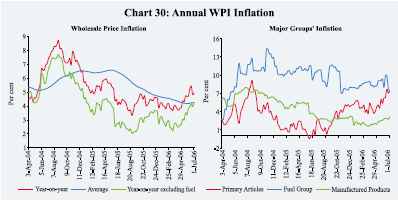
Prices of primary food articles also posed upward pressures on headline inflation during the first quarter of 2006-07 (Chart 31). Wheat prices, which had firmed up till March 2006 on reports of fall in stocks, moderated somewhat during April-June 2006. Nonetheless, wheat prices, on a year-on-year basis, have increased by about 8.8 per cent as on July 1, 2006. Vegetables prices have increased by about 51 per cent over end-March 2006 (almost the same order of increase as a year ago) reflecting the seasonal hardening patterns. Prices of pulses also edged higher from last year’s level reflecting stagnant domestic production as well as higher demand. In order to improve domestic supplies so as to stabilise inflation expectations, the Government, during June 2006, took fiscal measures such as exempting imports of pulses and sugar from customs duty (till March 31, 2007 and September 30, 2006, respectively), allowing import of wheat at a concessional rate of 5 per cent customs duty (till end-December 2006) and restriction on exports of pulses. Oilseeds prices have increased since end-March 2006 on concerns about progress of monsoon. Overall, prices of primary articles have increased by 5.0 per cent since end-March 2006 (as compared with an increase of 3.1 per cent in the corresponding period of the previous year). On a y-o-y basis, prices of primary articles have increased by 7.4 per cent as compared with a marginal increase (0.2 per cent) a year ago. As a result, the primary articles contribution to headline inflation increased to 32 per cent as on July 1, 2006 from a negligible level a year ago.
Manufactured products inflation remained relatively modest – 3.2 per cent, y-o-y, as on July 1, 2006 as compared with 3.3 per cent a year ago. Competitive pressures, productivity gains as well as strong corporate profitability have provided firms the flexibility to absorb higher input costs into their profit margins. Furthermore, pre-emptive monetary actions by anchoring inflation expectations
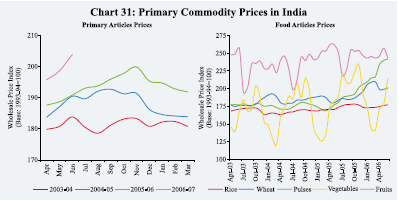
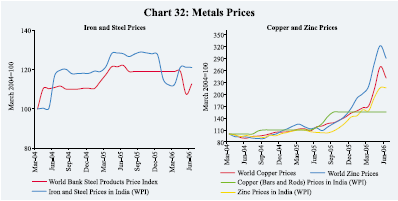
have restrained the second order effects of past increases in oil prices to manufactured products prices. Manufactured products inflation was led by a few commodities such as sugar, chemicals, cement and non-ferrous metals. Notwithstanding higher domestic sugarcane output, sugar prices have remained firm in line with international trends. In order to contain rising sugar prices, the Government, on June 22, 2006, as noted earlier, allowed duty-free imports of sugar till September 2006. Metal prices have moved in line with international trends (Chart 32). Non-ferrous metal prices rose sharply – prices of copper and zinc increased, y-o-y, by about 23 per cent and 96 per cent, respectively, on July 1, 2006. In contrast, the turnaround in iron and steel prices – a decline of 2.3 per cent, y-o-y, as on July 1, 2006 as against an increase of 6.3 per cent a year ago –contributed to some moderation in headline inflation. Although domestic iron and steel prices have declined on a y-o-y basis, they have edged up since March 2006 (an increase of 9.8 per cent) in tandem with international price movements.
In brief, domestic WPI inflation during 2006-07 so far (as on July 1, 2006) continues to be dominated by mineral oils prices, which alone contributed about 34 per cent to the y-o-y headline inflation. Primary articles’ contribution to the overall y-o-y inflation was 32 per cent mainly due to higher prices of wheat, pulses, vegetables, milk, and eggs, meat and fish (Chart 33). Manufactured products’ contribution fell to 36 per cent (45 per cent a year ago), largely on account of a decline in iron and steel prices.
Consumer Price Inflation
Consumer price inflation edged up, especially during May 2006, largely reflecting higher prices of food items (Table 30). As food prices have a higher
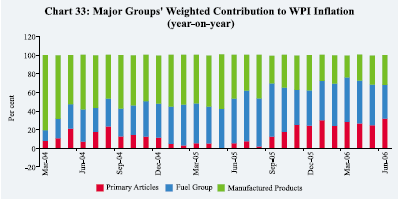
weight in the CPI vis-à-vis the WPI, the CPI inflation has remained higher than the WPI inflation since November 2005. WPI inflation was, on the other hand, higher than CPI inflation during the first half of 2005-06 reflecting higher fuel and metals prices which have higher weights in the WPI vis-à-vis CPI (Chart 34).
Asset Prices
Equity and gold prices, after having recorded sharp gains during 2005-06, witnessed some correction in the first quarter of 2006-07. Following higher than anticipated inflation in the US, global commodity prices and equity markets recorded losses in May 2006 on concerns that monetary tightening might slow prospects for global growth. In consonance with these international trends, domestic equity prices fell during May and early June 2006. Equity prices recovered somewhat in the second half of June 2006 and by end-June 2006, equity prices were down by around 6 per cent over end-March 2006 (Chart 35). International gold prices which rose to US $ 715 per ounce on May 12, 2006
| Table 30: Consumer Price Inflation (CPI) in India (year-on-year) |
|||||||
| (Per cent) |
|||||||
| Inflation Measure |
March 2003 |
March 2004 |
March 2005 |
March 2006 |
April 2006 |
May 2006 |
|
| 1 |
2 |
3 |
4 |
5 |
6 |
7 |
|
| CPI-IW |
4.1 |
3.5 |
4.2 |
4.9 |
5.0 |
6.3 |
|
| CPI- UNME |
3.8 |
3.4 |
4.0 |
5.0 |
5.0 |
5.8 |
|
| CPI-AL |
4.9 |
2.5 |
2.4 |
5.3 |
5.6 |
6.4 |
|
| CPI-RL |
4.8 |
2.5 |
2.4 |
5.3 |
5.2 |
6.4 |
|
| Memo: |
|||||||
| WPI Inflation (end-month) |
6.5 |
4.6 |
5.1 |
4.1 |
3.9 |
4.7 |
|
| IW : Industrial Workers UNME : Urban Non-Manual Employees |
|||||||
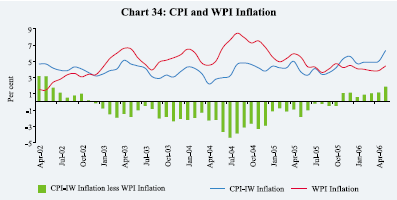
witnessed sharp correction and fell to US $ 559 as on June 14, 2006 in consonance with the trends in various commodities in the international market. Prices have since then recovered and were US $ 624 per ounce as on July 19, 2006. Domestic gold prices, after crossing Rs.10,000 per 10 grams in mid-May 2006, witnessed correction in line with international trends and fell to about Rs.8,470 per 10 grams on June 14, 2006. Prices recovered to about Rs.9,500 per 10 grams as on July 19, 2006. Gilt prices fell and yields rose further during the first quarter of 2006-07 on the back of increase in yields in major economies, concerns over domestic inflation in view of higher oil prices and the hike in the reverse repo rate.
